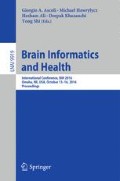Abstract
Large-scale brain knowledge bases, such as Linked Brain Data, integrate and synthesize domain knowledge on the brain from various data sources. Although it is designed to provide comprehensive understanding of the brain from multiple perspectives and multi-scale, the correctness and specificity of the extracted knowledge is very important. In this paper, we propose a framework of relation inference and relation type identification to solve the upper problem. Firstly, we propose a quadrilateral closure method based on the network topology to verify and infer the binary relations. Secondly, we learn a model based on artificial neural network to predict the potential relations. Finally, we propose a model free method to identify the specific type of relations based on dependency parsing. We test our verified relations on the annotated data, and the result demonstrates a promising performance.
Access this chapter
Tax calculation will be finalised at checkout
Purchases are for personal use only
Notes
- 1.
Linked Brain Data: http://www.linked-brain-data.org.
References
Banko, M., Cafarella, M.J., Soderland, S., Broadhead, M., Etzioni, O.: Open information extraction from the web. In: Proceedings of the 20th International Joint Conference on Artificial Intelligence, vol. 7, pp. 2670–2676 (2007)
Beale, M.H., Hagan, M.T., Demuth, H.B.: Neural Network Toolbox 7 User’s Guide. MathWorks Inc., Natick (2010)
Bunescu, R.C., Mooney, R.J.: A shortest path dependency kernel for relation extraction. In: Proceedings of the Conference on Human Language Technology and Empirical Methods in Natural Language Processing, pp. 724–731. Association for Computational Linguistics (2005)
Chen, D., Manning, C.D.: A fast and accurate dependency parser using neural networks. In: Proceedings of the 2014 Conference on Empirical Methods in Natural Language Processing, pp. 740–750. Association for Computational Linguistics (2014)
Culotta, A., Sorensen, J.: Dependency tree kernels for relation extraction. In: Proceedings of the 42nd Annual Meeting on Association for Computational Linguistics, p. 423. Association for Computational Linguistics (2004)
Easley, D., Kleinberg, J.: Strong and weak ties. In: Networks, Crowds, and Markets: Reasoning About a Highly Connected World, pp. 47–84. Cambridge University Press (2010)
Granovetter, M.S.: The strength of weak ties. Am. J. Sociol. 78, 1360–1380 (1973)
Grigni, M., Papadias, D., Papadimitriou, C.: Topological inference. In: Proceedings of the 14th International Joint Conference on Artificial Intelligence, pp. 901–907 (1995)
Hasegawa, T., Sekine, S., Grishman, R.: Discovering relations among named entities from large corpora. In: Proceedings of the 42nd Annual Meeting on Association for Computational Linguistics, p. 415. Association for Computational Linguistics (2004)
Jin, S.C., Pastor, P., Cooper, B., Cervantes, S., Benitez, B.A., Razquin, C., Goate, A., Cruchaga, C.: Pooled-DNA sequencing identifies novel causative variants in PSEN1, GRN and MAPT in a clinical early-onset and familial Alzheimer’s disease ibero-American cohort. Alzheimer’s Res. Ther. 4(4), 1 (2012)
Kossinets, G., Watts, D.J.: Empirical analysis of an evolving social network. Science 311(5757), 88–90 (2006)
Lee, W.C., Kang, D., Causevic, E., Herdt, A.R., Eckman, E.A., Eckman, C.B.: Molecular characterization of mutations that cause globoid cell leukodystrophy and pharmacological rescue using small molecule chemical chaperones. J. Neurosci. 30(16), 5489–5497 (2010)
Lieshout, R.J.V., MacQueen, G.: Psychological factors in asthma. Allergy Asthma Clin. Immunol. 4(1), 1 (2008)
Liu, L., Zhang, S., Diao, L., Yan, S., Cao, C.: Automatic verification of “isa” relations based on features. In: Proceedings of the Sixth International Conference on Fuzzy Systems and Knowledge Discovery, vol. 2, pp. 70–74. IEEE Press (2009)
Newcomb, T.M.: An approach to the study of communicative acts. Psychol. Rev. 60(6), 393–404 (1953)
Rapoport, A.: Spread of information through a population with socio-structural bias: Iii. Suggested experimental procedures. Bullet. Math. Biophys. 16(1), 75–81 (1954)
Richardet, R., Chappelier, J.C., Telefont, M., Hill, S.: Large-scale extraction of brain connectivity from the neuroscientific literature. Bioinformatics 31(10), 1640–1647 (2015)
Soffer, S.N., Vazquez, A.: Network clustering coefficient without degree-correlation biases. Phys. Rev. E 71(5), 057101 (2005)
Zeng, D., Liu, K., Lai, S., Zhou, G., Zhao, J.: Relation classification via convolutional deep neural network. In: Proceedings of the 25th International Conference on Computational Linguistics, pp. 2335–2344 (2014)
Zeng, Y., Wang, D., Zhang, T., Xu, B.: Linked neuron data (lnd): a platform for integrating and semantically linking neuroscience data and knowledge. In: Frontiers in Neuroinformatics. Conference Abstract: The 7th Neuroinformatics Congress (Neuroinformatics 2014), Leiden, the Netherlands (2014)
Zhu, H., Zeng, Y., Wang, D., Xu, B.: Brain knowledge graph analysis based on complex network theory. In: Selvaraj, R., Meyer, V. (eds.) BIH 2016. LNAI, vol. 9919, pp. 211–220. Springer, Berlin (2016)
Acknowledgment
This study was funded by the Strategic Priority Research Program of the Chinese Academy of Sciences (XDB02060007), and Beijing Municipal Commission of Science and Technology (Z151100000915070, Z161100000216124).
Author information
Authors and Affiliations
Corresponding author
Editor information
Editors and Affiliations
Rights and permissions
Copyright information
© 2016 Springer International Publishing AG
About this paper
Cite this paper
Zhu, H., Zeng, Y., Wang, D., Xu, B. (2016). Relation Inference and Type Identification Based on Brain Knowledge Graph. In: Ascoli, G., Hawrylycz, M., Ali, H., Khazanchi, D., Shi, Y. (eds) Brain Informatics and Health. BIH 2016. Lecture Notes in Computer Science(), vol 9919. Springer, Cham. https://doi.org/10.1007/978-3-319-47103-7_22
Download citation
DOI: https://doi.org/10.1007/978-3-319-47103-7_22
Published:
Publisher Name: Springer, Cham
Print ISBN: 978-3-319-47102-0
Online ISBN: 978-3-319-47103-7
eBook Packages: Computer ScienceComputer Science (R0)

